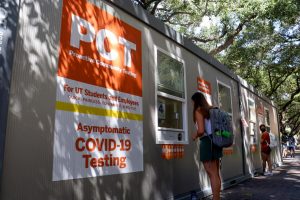UT-Austin researcher finds sanctuary policies lower crime rates
July 21, 2022
Editor’s note: This article first appeared in the July 19, 2022 flipbook.
Sanctuary counties that didn’t enforce immigration laws saw lower amounts of violent crime and property crime, according to a study by a UT researcher.
Recent Ph.D. graduate Marta Ascherio found that counties with higher proportions of Latinx immigrants saw lower crime rates after implementing sanctuary policies. These policies are an attempt to prevent law enforcement agencies from enforcing immigration laws or arresting individuals based on immigration status, but can vary depending on state and city, Ascherio said.
Ascherio studied over 3,000 counties across the United States, 123 of which were considered sanctuary counties.
“Sanctuary policies free up people’s time and energy to invest in their families and communities and schools and local politics,” said Ascherio, a soon-to-be assistant professor of criminal justice sciences and Latin American and Latino studies at Illinois State University. “If people are so worried about just being safe, it’s harder to walk your kids to school or to make a business plan or to open a bank account.”
Although the counties saw a decrease in crime rates, sanctuary counties also saw an increase in crime reporting compared to non-sanctuary counties, Ascherio said.
“In sanctuary counties, people feel more comfortable contacting the police because they don’t feel that police surveillance is going to be turned onto them, even if they’re just calling as the witness or as a victim,” Ascherio said. “That means the decreases in crime I found are actually conservative estimates because the sanctuary policies increased crime reporting but decreased crime.”
Gov. Greg Abbott outlawed all sanctuary practices in Texas in 2017, making it a misdemeanor for police officers not to cooperate with U.S. Immigration and Customs Enforcement. Kristen Dark, the senior public information officer for the Travis County Sheriff’s Office, said in an email that the sheriff’s office does not collect the nationality or immigration status of 911 callers or people who report crimes.
Sociology professor Néstor Rodríguez said that many immigrants’ shared culture and close family ties decrease crime rates. Ascherio said because some immigrants move with their families, they are able to broaden their social network. She said the family connections and supervision of children in immigrant communities make the community more stable.
“What (Ascherio) established is there’s this inverse relationship between sanctuary policies and crime rates,” Rodríguez said. “What we need to do now is to take (Ascherio’s) research, and try to determine what specifically are the causal effects here? Why does this happen?”
















